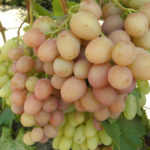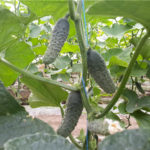Tomato variety Mikado
The name of this tomato variety is known to many. But not everyone knows that the color of this variety is not limited to the traditional red or pink color. In fact, Mikado has many faces, that is, it is represented by a large number of colored varieties. But, despite its immense popularity, the history of the creation of the variety remains unclear. Only one is included in the State Register - Mikado pink, the rest are often sold by amateur breeders or tomato growers who share interesting specimens with each other. Let's try to find out as much useful information as possible about each colored representative of this large family.
Mikado Pink
Let's start with it because this variety has passed state tests, which means it has confirmed characteristics. The creation of a pink-fruited species in 2013 was announced by Gavrish Breeding Company LLC. It was entered into the State Register in 2015 with admission in all regions of the country. Recommended for foil greenhouses in personal subsidiary plots. Suitable for open ground in southern regions. It is this variety that is considered by many gardeners to be the standard of taste and smell of those very tomatoes from childhood. The tomato is not a hybrid, so you can harvest the seeds yourself.
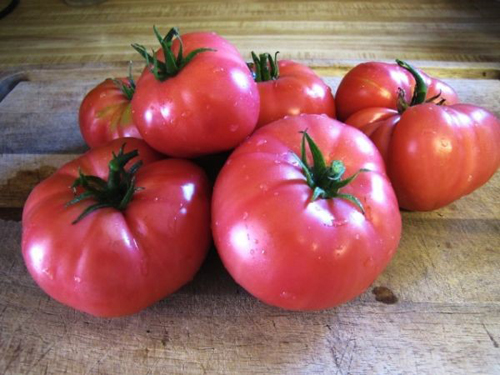
Description
The plant is indeterminate, 1.5 - 1.8 meters high. In a greenhouse, this indicator may well outgrow. The bush is not very powerful, the shoot-forming ability and leafiness are moderate. This species is characterized by potato-type leaves, medium-sized, dark green, moderately wrinkled. The inflorescence is of a simple type. The first fruit cluster in pink Mikado appears above the 7th leaf, in each cluster there are 3 - 4 ovaries. 6 inflorescences are formed on the stem.
The fruits of the variety are flat-round, ribbed, moderate density. The skin is thin, shiny. Unripe tomato is light green, with a dark spot at the stalk. When ripe, it acquires a beautiful deep pink hue, the stain disappears. The pulp is fleshy, juicy, aromatic, with a high sugar content, multi-chamber (6 seed chambers or more), but the chambers are small and contain a small amount of seeds. In the State Register, the taste is marked as excellent, which is confirmed by many tomato growers. The variety belongs to large-fruited. The mass of a tomato according to the State Register is 300 - 360 grams, in other sources the weight is slightly more modest - from 200 to 300 grams. The maximum indicator is 940 grams. The largest specimens ripen on the first cluster.
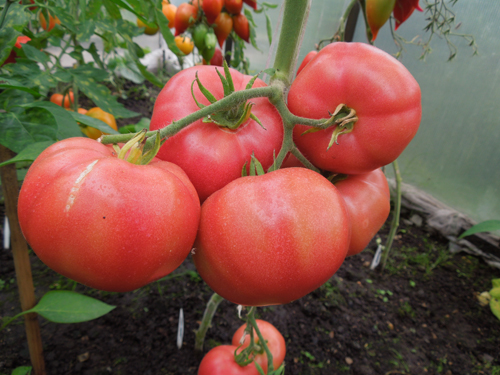
Characteristics
- Mikado pink State Register refers to the mid-early varieties. According to the available information, the onset of maturation occurs 96 - 102 days after the appearance of full entrances. Although there is information that in cooler regions, the moment of ripening occurs somewhat later - on the 120th day;
- yield about 5.0 - 6.0 kg per 1 square meter (according to the State Register). According to other information - 10 - 12 kg per 1 sq. meters;
- with regard to immunity, the creators note a high resistance to various diseases characteristic of culture. Gardeners confirm this characteristic;
- during a period of high humidity, the fruits may crack;
- the fruits are used to prepare fresh salads and freshly squeezed juice. Tomatoes are not suitable for canning because of their large size and fragile skin.
Agrotechnics
It is recommended to grow the variety in seedlings, regardless of the regions. Sowing for seedlings is carried out 55 - 60 days before the intended transplantation into the ground. Picking - at the stage of 2 true leaves. The pink Mikado indent requires a mandatory tie to a support or trellis. In cool regions, the plant is formed into 1 or 2 stems. In the middle or end of August, the stem is pinched over the upper fruit cluster, leaving 2 leaves above it. Removing the lower leaves under the ripe fruit brush and pinching accelerate the ripening of the remaining tomatoes. In the southern regions, the plant is often formed into 3 or 4 stems.Planting density - 3 bushes per 1 square meter, when formed into 1 stem, up to 4 plants can be compacted. Care is fully consistent with the generally accepted - sufficient watering, feeding, loosening and weeding. It is important to maintain normal temperature and humidity in the greenhouse.
The pink-fruited variety is valued for its excellent taste and presentation of ripe fruits. This culture is for those gourmets who appreciate the sugary taste and fleshy flesh, but do not pursue a record harvest. A big plus is that you can harvest the seeds yourself if you want.
Mikado black
This variety is probably the most exotic of its kind. All thanks to the unusual color. A kind of amateur selection, spread by amateur breeders. Not listed in the State Register. Not a hybrid.
Description
The plant is indeterminate, 1.5 meters high. Even in a greenhouse, this figure is rarely exceeded. The bush is not branched, slightly leafy. Potato-type leaf, green, medium-sized, slightly wrinkled. The inflorescence is simple. On the main stem, on average, about 5 racemes are formed, each of which contains from 3 to 5 ovaries. The peduncle is articulated. Tomatoes are flat-rounded or rounded, sometimes with ribbing, moderately elastic. The skin is thin, glossy. Unripe tomato is green, with a darker spot at the stalk. When ripe, it acquires a rather unusual color - burgundy-brown.
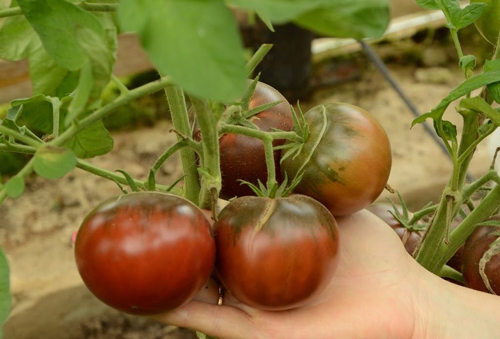
The pulp is fleshy, tender, juicy, but with a slight separation of liquid when cut. The flesh is reddish-greenish in color. The aroma is very pronounced, pleasant. There are many seed cavities - from 6 and more, but they are small, contain a small amount of seeds. The taste is noted as excellent, sweet, but a slight sourness is present. The average fruit weight is about 200 - 300 grams.
Characteristics
- According to reviews, the black-fruited variety belongs to the early-maturing species;
- Mikado black is considered one of the most productive among fellows;
- adapts to environmental conditions, therefore, in addition to closed ground, it is successfully cultivated in the open;
- the variety is disease-resistant (however, to which specific diseases is not specified);
- fruits are prone to cracking;
- the method of consumption is salad, but tomatoes are suitable for juicing.
- You can also grow this species, as already described above. The black-fruited variety is valued for its taste, unusual color and yield.
Mikado red
The seeds of this red-fruited species are also not distributed by well-known seed companies, but you can still find them on sale (even on foreign sites). The variety is suitable for cultivation in open and closed ground, but it thrives especially well in dry and hot climates. Not included in the State Register. Not a hybrid.
Description
The plant is indeterminate, tall - 1.5 meters. According to numerous descriptions, in a greenhouse, the height of the plant exceeds 2 meters. Leaves are of the usual type, dark green, medium in size. The first fruit cluster appears above 7 - 8 leaves, subsequent ones are formed every 2 - 3 leaves. Each cluster has 7 - 8 ovaries. The fruits of the variety are flat-round, slightly ribbed, rather dense. Ripe tomato turns into a deep red color. The pulp is fleshy, juicy, tender. The taste is excellent, there is a high sugar content, which is why sweetness prevails in the taste. The dry matter content is about 6%. The variety is large-fruited, the mass of tomatoes is 300 - 350 grams, the maximum weight is 600 grams.
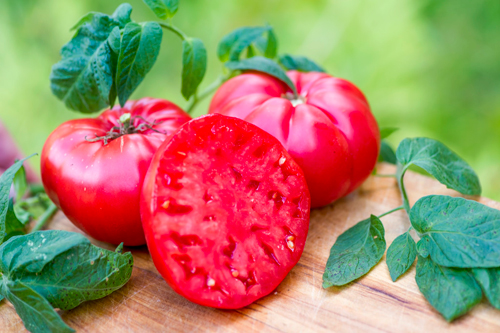
Characteristics
- The ripening period of the red-fruited Mikado variety is medium late, ripening occurs 115 - 120 days after the appearance of full shoots;
- fruiting period - from July to October;
- yield 8 - 10 kg per 1 square meter;
- the culture has increased resistance to adverse weather conditions;
- disease resistance is good;
- tomatoes do not crack;
- keeping quality and transportability of fruits at a high level;
- the way of eating tomatoes is universal. The harvest is primarily used in its natural form for the preparation of salads. In addition, the fruits are suitable for baby and diet food. Shows high salting qualities, suitable for canning.
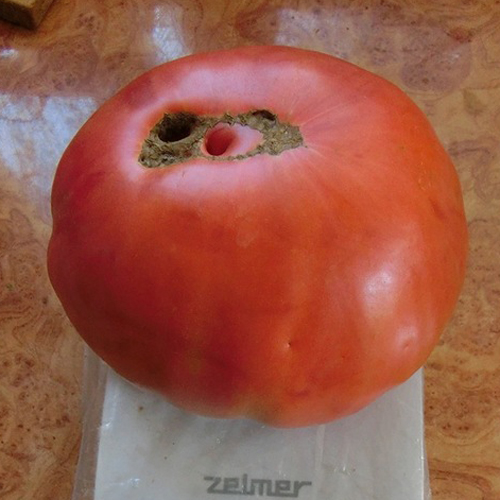
Agricultural technology is similar to the generally accepted one. Seedlings are planted at the age of 55 - 70 days. Watering is carried out with warm water, trying not to get on the leaves and fruits. The first feeding is carried out 2 weeks after transplanting (5-10 grams of ammonium nitrate and superphosphate per 1 square meter). In subsequent dressings, you can alternate organic matter and mineral fertilizers. The variety is valued for its excellent yield, large fruit size, unpretentiousness and versatile use of the crop.
Mikado yellow
The yellow-fruited species is not included in the State Register, nothing is known about the creators either. Gardeners highly appreciated this variety for its taste. Purpose - for spring film greenhouses. Not a hybrid.
The tomato belongs to the indents. Normal leaf, dark green. Fruit clusters are tied through 2 - 3 leaves, each forming 3 - 4 ovaries. Fruits are flat-round, may have pronounced ribbing. The skin is yellow, glossy. The pulp is fleshy, juicy and tender, there are many seed chambers (more than 6), but they are small and low-seeded. The taste is excellent, the taste is sweet. Average weight of fruits is 200 - 250 grams, maximum - 500 grams.
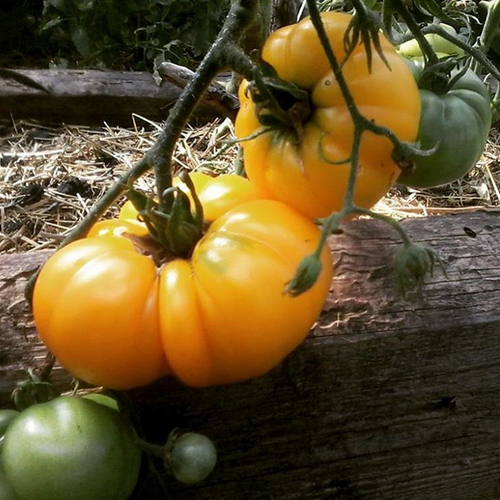
In terms of ripening, yellow Mikado is medium late - tomatoes begin to ripen 111 - 120 days after full shoots appear. Productivity 6 - 8 kg per 1 square meter. With high humidity, the fruits are prone to cracking near the stalk and along. At the stage of technical ripeness, tomatoes are well stored, well ripened. Directions for use - in natural form, for salads. The care is usual for indents.
Mikada orange
This orange-fruited variety (not a hybrid) appeared thanks to the efforts of the agricultural company Aelita. It does not appear in the State Register. But gardeners speak very enthusiastically about its taste, it is this variety, in the opinion of many, is the sweetest. Purpose - for open ground in warm regions and for film shelters in cool ones. Ripening early - 85 - 100 days after full first shoots. According to the description of tomato growers, the growth of a tomato is about 2 meters. Fruit raceme of intermediate type, loose. There are many ovaries, but experienced gardeners recommend normalizing it, leaving about 3 fruits. The color of ripe tomatoes is deep orange due to the increased content of beta-carotene. The care is carried out as usual.
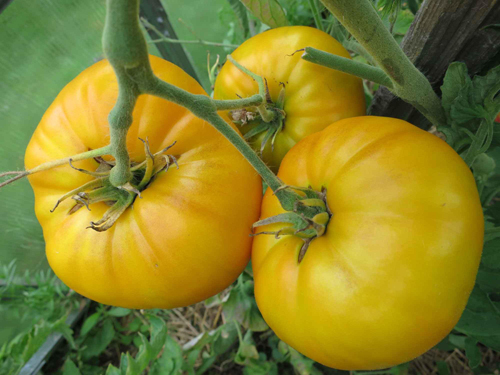
Mikado Siberiko
This is a real Siberian. Siberian breeders have created the variety as a result of long-term selection and adaptation of the culture to the conditions of Western Siberia. Originators - "Siberian Garden". The tomato does not appear in the State Register. The plant is indeterminate, large-fruited, recommended for growing in greenhouses and in the open field. The fruits are heart-shaped; at the stage of consumer ripeness they acquire a pink-raspberry color. The mass of tomatoes is 400 - 600 grams (according to reviews, the usual weight of fruits is 250 - 350 grams, but they were also larger). Some specimens can reach a kilogram weight. The pulp is very fleshy, low-seeded, without voids. The taste is excellent. Tomatoes are not prone to cracking, but they do not last long. The way of eating the fruit is in its natural form, it can also be processed into tomato products (pastes, sauces, juice). Subject to the rules of agricultural technology, the originators promise up to 8 kg from one bush. Agrotechnology is common, but garter and shaping is required. The seeds can be harvested by yourself.
In addition to the species already described, there is a white variety in the Mikado collection. According to some reports, this is a French selection, and the variety is called Micado Blanc. Described as rare, fruitful, sweet flesh with a fruity flavor. The average weight of tomatoes is 150 - 200 grams.
Mikado golden is also sometimes mentioned in various Internet sources, but most likely it is the same yellow variety, but under a new name.
Summing up the description of the numerous imperial family, we can safely say that Mikado is really loved and popular among tomato growers. But you still need to be careful about buying seed. If you are satisfied with the result obtained, you can safely collect seeds for further cultivation and share them with your friends.

